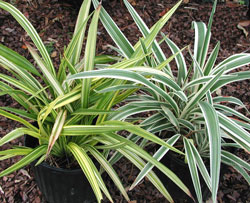Resource Library
Plant of the Week: Lily, Flax
The University of Arkansas System Division of Agriculture does not promote, support or recommend plants featured in "Plant of the Week." Please consult your local Extension office for plants suitable for your region.
Plant of the Week
Flax Lilies
Latin: Dianella tasmanica

Strolling through a South Carolina nursery in the fall of 2001, I came across some grass-like plants that were new to me. They were labeled as variegated versions of Dianella tasmanica - commonly known as flax lilies.
I bought the golden-variegated clone called 'Gold Stripe,' while Joel Stout, a Conway nurseryman, bought the white-variegated selection called 'Variegata.'
Dianellas are a group of around 25 lily-like perennials found in the Asian tropics, parts of Africa, the wetter parts of Australia and scattered amongst the Polynesian islands. Long considered members of the lily family, they're now combined with the more common New Zealand flax into a separate family called the Phormiaceae.
Dianella tasmanica grows as a frost-tender, freely branching rhizomatous perennial reaching 2 feet tall in cultivation. The flat and glossy leaves are about an inch wide and marked with yellow in 'Gold Stripe' and white in 'Variegata.' In my experience, the golden variegated form is more vigorous than the white variegated version which may be a different species, possibly a selection of D. intermedia.
Clusters of six-petaled, light blue flowers about half an inch across with prominent yellow stamens are produced in mid spring. In southern California and in their native haunts, the cute, but small, flowers are followed by olive-sized bright blue berries. A common name for the plant in Australia is "Blue Berry." There, the plant is more often grown for its showy clusters of berries than its ornamental foliage.
As so often happens with new plants, the story of their introduction into our gardens is poorly documented. The species was first described by Joseph Hooker, the long-serving director of Kew Gardens in London, in 1860. Fifty years later, Bailey described "variegata" but listed it as yellow and says "they (the Dianella) are little known in this country." Other authors mention it through the 20th century, but it seems to have remained primarily in botanic garden collections.
In the 1980s, Rodney Henderson, an Australian botanist, did considerable taxonomic work on the flax lilies and probably stirred interest in them amongst Australian nurserymen. In 1995, one Australian nurseryman began a breeding program using other Dianella species and has recently patented several selections from the thousands of seedlings he has grown. It was during this period that the new plant craze swept through the land. Though far from common, the old variegated Dianella clones are seen here and there amongst the offerings of nurseries.
Flax lilies need to be treated as any other frost-tender garden plant. They should be brought in before the first frost and planted out every spring after the danger of frost is past. They must be given enough light in the winter to keep their foliage alive.
Flax lilies are fast growing and work well in containers or in partially shaded beds with average fertility and moisture. I've overwintered my plants in a cool greenhouse or amongst the houseplants near the windowsill. I divide them in the spring before planting out.
By: Gerald Klingaman, retired
Extension Horticulturist - Ornamentals
Extension News - July 7, 2006
The University of Arkansas System Division of Agriculture does not maintain lists of retail outlets where these plants can be purchased. Please check your local nursery or other retail outlets to ask about the availability of these plants for your growing area.